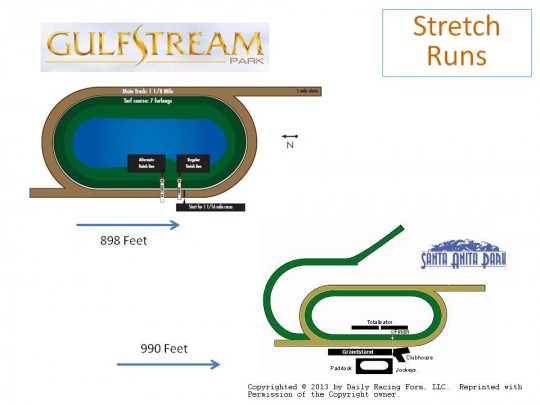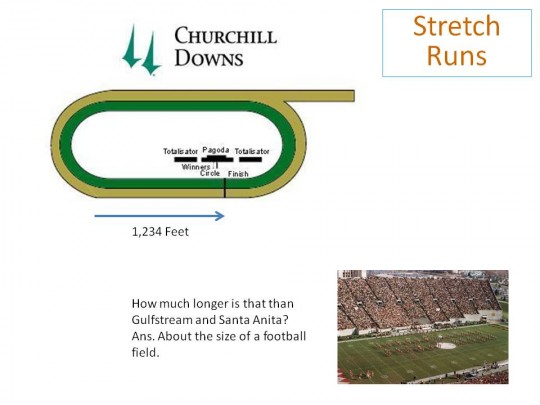Recent Derby Trends – Long Stretch Runs Make Better Preps
UPDATE: Article was updated on April 25, 2015 to include information from the 2014 Kentucky Derby.
In a seminar this past week I provided some trends about recent Kentucky Derby winners and other horses that have finished in the money for the Derby. Part of this discussion was explaining the special challenge of distance for Derby contestants and related to that, the added challenge of horses facing a stretch run that is quite long at Churchill Downs.
As most people are aware, the Kentucky Derby is 1 1/4 mile (10 furlongs) long. A distance that no horse in the field has ever run prior to the Derby. That alone is challenge enough. In addition to that, many of the horses are coming from racetracks that have a stretch run considerably shorter than at Churchill Downs. Below is a slide I gave in the presentation that shows the stretch runs for Gulfstream Park and Santa Anita Park. The length of the stretch runs are shown in feet beneath the blue arrows.
Let’s compare that to the stretch run at Churchill Downs in another slide from my presentation.
I often hear people talking about the “speed favoring” surfaces of Santa Anita and Gulfstream Park. I think these diagrams point out nicely that it might be more than just the surface. Unlike Gulfstream and Santa Anita, at Churchill Downs, after horses make that final turn for home, they have much more ground (and opportunity) to catch the pacesetters in the race. That might explain why in the past 29 years, only three times has a “Wire” type horse won the Kentucky Derby on a fast track.
In case you’re wondering how Churchill Downs compares to some other major racetracks in stretch runs, click here to read an article that has a chart of most major tracks in the United States and their stretch run size.
The question was asked in the seminar, how many favorites have won the Kentucky Derby? Surprisingly, in recent years, five (California Chrome, Orb, Big Brown, Street Sense, and Smarty Jones) of the last eleven favorites have won the Kentucky Derby. A 45% win rate for favorites is a bit surprising, especially given the size of the Derby fields. And, if you go back further, prior to Fusaichi Pegasus’ win in the year 2000, from 1980 to 1999 (twenty years) there were exactly ZERO favorites that won the Derby.
We discussed the average payouts in recent years. Going back 25 years, we found the average Win Price to be around $30. What was a little more surprising was the average payout for the Exacta was slightly over $800. And, although the gigantic exacta payout of $9,800 in 2005 (Giacomo and Closing Argument) skews that a bit, consider that in 2013, the exacta paid $981 … with the favorite (Orb) winning the race. And in 2014 it paid $340, with favorite California Chrome winning also. Trifecta payouts have averaged over $12,500 in the past 25 years, and the last 7 straight Derby trifectas have paid more than $2,300.
After I returned from the seminar on Monday night, I started thinking about the high payouts for Win, Exacta, and Trifecta wagers on the Derby (all bets dependent on knowing the horses that finish In-The-Money). Considering the variations in stretch runs discussed previously, I decided to go back ten years and chart the 1-2-3 finishers in each Kentucky Derby … showing the racetrack where they had run their previous race. I found some surprising results. Below is a chart – showing year by year the race track where the top three finishers in the Derby had their prior race.
| Kentucky Derby Finishers Prior Race | |||
|---|---|---|---|
| Year | Win | Place | Show |
| 2014 | Santa Anita | Fairgrounds | Oaklawn |
| 2013 | Gulfstream | Fairgrounds | Fairgrounds |
| 2012 | Santa Anita | Oaklawn | Keeneland |
| 2011 | Turfway | Oaklawn | Fairgrounds |
| 2010 | Oaklawn | Gulfstream | Keeneland |
| 2009 | Sunland | Santa Anita | Hawthorne |
| 2008 | Gulfstream | Oaklawn | Hawthorne |
| 2007 | Keeneland | Turfway | Oaklawn |
| 2006 | Gulfstream | Keeneland | Oaklawn |
| 2005 | Santa Anita | Keeneland | Oaklawn |
| 2004 | Oaklawn | Keeneland | Santa Anita |
Just glancing down this list, it might not jump out at you, but the racetrack that has sent the most number of In-The-Money finishers to the Kentucky Derby in the last eleven years is Oaklawn Park. Below is a summary of the above chart that points this out much clearer. For reference, relating back to what was discussed at the top of the article are the stretch runs for each of these racetracks.
| Prep Racetrack | Derby ITM Finishers | Stretch Run (in feet) |
|---|---|---|
| Oaklawn | 9 | 1155 |
| Keeneland | 6 | 1174 |
| Santa Anita | 5 | 990 |
| Fairgrounds | 4 | 1346 |
| Gulfstream | 4 | 898 |
| Turfway | 2 | 970 |
| Hawthorne | 2 | 1320 |
| Sunland | 1 | 990 |
What I find most interesting from this summary is that the two racetracks that have sent the most number of In-The-Money finishers to the Kentucky Derby have a stretch run very similar in length to that of Churchill Downs.
You can’t argue that six of the last eleven Derby winners had their prior race at Gulfstream or Santa Anita Park. But, with that said, only three other GP or SA horses finished in the top three. So, if you’re looking for horses to include in your exacta, trifecta, or superfecta wagers … I’d give a look to horses coming from racetracks with a long stretch run.



8 comments on “Recent Derby Trends – Long Stretch Runs Make Better Preps”